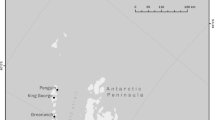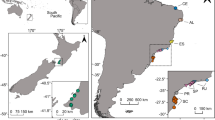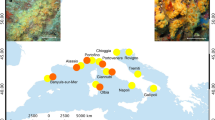Abstract
For many sedentary or sessile benthic marine invertebrates the planktonic duration of the larval stage is believed to be a key determinant of the magnitude of genetic differences between populations. An obvious dichotomy in dispersal potential exists within cheilostome bryozoans that develop from either (1) a cyphonautes larva that spends several weeks in the plankton or (2) a brooded coronate larva that settles soon after release from the adult colony. This study characterises the pattern of variation at allozyme loci among British populations of four species of bryozoan—two species with cyphonautes and two with coronate larvae. There is some variation in the estimates of genetic differentiation among similarly separated populations that may be a consequence of non-equilibrium genetic conditions arising from sporadic migration, possibly through dispersal by rafting on macroalgae by mature colonies. Despite this, however, both the level of genetic differentiation between populations and the pattern of migrant exchange correlate with the larval developmental mode. Bryozoan species that brood coronate larvae show higher levels of genetic heterogeneity between populations and significant isolation by distance genetic structure while, by contrast, distance has little or no effect upon the amount of genetic differentiation among populations of bryozoans with cyphonautes larvae. For cheilostome bryozoans, therefore, it appears that genetic differentiation between populations is directly associated with the type of larval development. These data are discussed also with respect to levels of gene diversity and the geological pattern of cheilostome bryozoan species diversity.


Similar content being viewed by others
References
Allcock AL, Brierly AS, Thorpe JP, Rodhouse PG (1997) Restricted gene flow and evolutionary divergence between geographically separated populations of the Antarctic octopus Pareledone turqueti. Mar Biol 129:97–102
Anil AC, Venkat K, Sawant SS, Dileepkumar M, Dhargalkar VK, Ramaiah N, Harkantra SN, Ansari ZA (2002) Marine bioinvasion: concern for ecology and shipping. Curr Sci 83:214–218
Barnes DKA, Milner P (2005) Drifting plastic and its consequences for sessile organism dispersal in the Atlantic Ocean. Mar Biol 146:815–825
Bohonak AJ (1999) Dispersal, gene flow, and population structure. Q Rev Biol 74:21–45
Burton RS (1983) Protein polymorphisms and genetic differentiation of marine invertebrate populations. Mar Biol Lett 4:193–206
Burnett WJ, Benzie JAH, Beardmore JA, Ryland JS (1994) High genetic variability and patchiness in a common Great Barrier Reef zoanthid (Palythoa caesia). Mar Biol 121:153–160
Carlton JT, Geller JB (1993) Ecological roulette: the global transport of nonindigenous marine organisms. Science 261:78–82
Carlton JT, Hodder J (1995) Biogeography and dispersal of coastal marine organisms: experimental studies on a replica of a 16th-century sailing vessel. Mar Biol 121:721–730
Chapman AS, Scheibling RE, Chapman ARO (2002) Species introductions and changes in marine vegetation of Atlantic Canada. In: Claudi R, Nantel P, Muckle-Jeffs E (eds) Alien invasive species in Canada’s waters, wetlands and forests. Natural Resources Canada, Ottawa, pp 133–148
Colson I, Hughes RN (2004) Rapid recovery o genetic diversity of dogwhelk (Nucella lapillus L.) populations after local extinction and recolonization contradicts predictions from life-history characteristics. Mol Ecol 13:2223–2233
Craddock C, Lutz RA, Vrijenhoek RC (1997) Patterns of dispersal and larval development of archaeogastropod limpets at hydrothermal vents in the eastern Pacific. J Exp Mar Biol Ecol 210:37–51
Crisp DJ (1978) Genetic consequences of different reproductive strategies in marine invertebrates. In: Battaglia B, Beardmore JA (eds) Marine organisms: genetics, ecology and evolution. Plenum Press, New York, pp 257–273
Edmands S, Potts DC (1997) Population genetic structure in brooding sea anemones (Epiactis spp.) with contrasting reproductive modes. Mar Biol 127:485–498
Falconer DS, Mackay TFC (1996) An introduction to quantitative genetics. Longman Group Ltd., Harlow
Frankham R, Ballou JD, Briscoe DA (2002) Introduction to conservation genetics. Cambridge University Press, Cambridge
Gilpin M (1991) The genetic effective size of a metapopulation. Biol J Linn Soc 42:165–175
Goldson AJ, Hughes RN, Gliddon CJ (2001) Population genetic consequences of larval dispersal mode and hydrography: a case study with bryozoans. Mar Biol 138:1037–1042
Goudet J (1994) FSTAT, a program for IBM PC compatibles to calculate Weir and Cockerham’s (1984) estimators of F-statistics. (version 1.2). Bangor University, privately distributed
Grant WS, Lang M (1991) Mode of larval development and genetic population structure in Nodolittorina africana knysnaensis (Prosobranchia: Littorinidae). Mar Biol 109:479–483
Grant WS, ds Silva-Tatley FM (1997) Lack of genetically-subdivided population structure in Bullia digitalis, a southern African marine gastropod with lecithotrophic development. Mar Biol 129:123–137
Hanski I (1999) Metapopulation ecology. Oxford University Press, New York
Hayward PJ, Ryland JS (1979) British ascophoran bryozoans. In: Kermack DM, Barnes RSK (eds) Synopses of the British Fauna, new series. Plenum Press, London
Hedgecock D (1986) Is gene flow from pelagic larval dispersal important in the adaptation and evolution and evolution of marine invertebrates? Bull Mar Sci 39:550–564
Hellberg ME (1994) Relationships between inferred levels of gene-flow and geographic distance in a philopatric coral, Ballanophyllia elegans. Evolution 48:1829–1854
Hellberg ME (1995) Stepping-stone gene flow in the solitary coral Ballanophyllia elegans: equilibrium and nonequilibrium at different spatial scales. Mar Biol 123:573–581
Hellberg ME (1996) Dependence of gene flow on geographic distance in two solitary corals with different larval dispersal capabilities. Evolution 50:1167–1175
Hewitt GM (2000) The genetic legacy of the Quaternary ice ages. Nature 405:907–913
Highsmith RC (1985) Floating and algal rafting as potential dispersal mechanisms in brooding invertebrates. Mar Ecol Prog Ser 25:169–175
Hilbish TJ (1996) Population genetics of marine species: the interaction of natural selection and historically differentiated populations. J Exp Mar Biol Ecol 200:67–83
Hoare K, Hughes RN, Goldson AJ (1999) Molecular genetic evidence for the prevalence of outcrossing in the hermaphroditic brooding bryozoan Celleporella hyalina. Mar Ecol Prog Ser 188:73–79
Hoskin MG (1997) Effects of contrasting modes of larval development on the genetic structures of populations of three species of prosobranch gastropods. Mar Biol 127:647–656
Hunt A (1993) Effects of contrasting patterns of larval dispersal on the genetic connectedness of local populations of two intertidal starfish, Patiriella calcar and P. exigua. Mar Ecol Prog Ser 92:179–186
Ingólfsson A (1995) Floating clumps of seaweed around Iceland: natural microcosms and a means of dispersal for shore fauna. Mar Biol 122:13–21
Jablonski D (1986) Larval ecology and macroevolution in marine invertebrates. Bull Mar Sci 39:565–587
Jablonski D, Lutz RA (1983) Larval ecology of marine invertebrates: paleobiological implications. Biol Rev 58:21–89
Jablonski D, Roy K (2004) Geographical range and speciation in fossil and living molluscs. Proc R Soc Lond Biol Sci 270:401–406
Janson K (1987) Allozyme and shell variation in two marine snails (Littorina, Prosobranchia) with different dispersal abilities. Bio J Linn Soc 30:245–256
Johannesson K (1988) The paradox of Rockall: why is a brooding gastropod (Littorina saxatilis) more widespread than one having a planktonic larval dispersal stage (L. littorea)? Mar Biol 99:507–513
Johannesson K, Tatarenkov A (1997) Allozyme variation in a snail (Littorina saxatilis)—deconfounding the effects of microhabitat and gene flow. Evolution 51:402–409
Johnson MS, Black R (1996) Geographic cohesiveness versus associations with habitat: genetic subdivision of Bembicium vittatum Phillipi (Gastropoda: Littorinidae) in the Houtman Abrolhos Islands. Bio J Linn Soc 58:57–74
Keough MJ, Chernoff H (1987) Dispersal and population variation in the bryozoan Bugula neritina. Ecology 68:199–210
Kimura M, Weiss GH (1964) The stepping stone model of population structure and the decrease of genetic correlation with distance. Genetics 49:561–576
Kyle CJ, Boulding EG (2000) Comparative population genetic structure of marine gastropods (Littorina spp.) with and without pelagic larval dispersal. Mar Biol 137:835–845
Lavery S, Moritz C, Fielder DR (1995) Changing patterns of population structure and gene flow at different spatial scales in Birgus latro (the coconut crab). Heredity 74:531–541
Malécot G (1948) Les mathématiques de l’hérédité. Masson, Paris
Marko PB (2004) ‘What’s larvae got to do with it?’ Disparate patterns of post-glacial population structure in two benthic marine gastropods with identical dispersal potential. Mol Ecol 13:597–691
McKinney FK, Jackson JBC (1991) Bryozoan evolution. University of Chicago Press, Chicago
Murphy RW, Sites JW Jr, Buth DG, Haufler CH (1990) Proteins I: isozyme electrophoresis. In: Hillis DM, Moritz C (eds) Molecular systematics. Sinauer Associates Inc., Sunderland, pp 45–126
Nishida M, Lucas JS (1988) Genetic differences between geographic populations of the Crown-of-thorns starfish throughout the Pacific region. Mar Biol 98:359–368
Palumbi SR (1994) Genetic divergence, reproductive isolation, and marine speciation. Ann Rev Ecol Syst 25:547–572
Porter JS, Ryland JS, Carvalho GR (2002) Micro- and macrogeographic genetic structure in bryozoans with different larval strategies. J Exp Mar Biol Ecol 272:119–130
Raymond M, Rousset F (1995) GENEPOP, Version 1.2. Population genetics software for exact tests and ecumenicisms. J Hered 86:249–249
Rice WR (1989) Analyzing tables of statistical tests. Evolution 43:223–225
Rousset F (1997) Genetic differentiation and estimation of gene flow from F-statistics under isolation by distance. Genetics 145:1219–1228
Ryland JS (1970) Bryozoans. Hutchinson University Library, London
Ryland JS, Hayward PJ (1977) British anascan bryozoans. In: Kermack DM, Barnes RSK (eds) Synopses of the British Fauna, new series. Plenum Press, London
Scheltema RS (1978) On the relationship between dispersal of pelagic veliger larvae and the evolution of marine prosobranch gastropods. In: Battaglia B, Beardmore JA (eds) Marine organisms: genetics, ecology and evolution. Plenum Press, New York, pp 303–322
Schopf TJM (1973) Population genetics of Ectroprocts: In: Larwood GP (ed) Living and fossil Bryozoa. Academic, London, pp 585–592
Schopf TJM (1977) Population genetics of bryozoans. In: Woollacott RM, Zimmer RL (eds) Biology of bryozoans. Academic, New York, pp 459–486
Schwaninger HR (1999) Population structure of the widely dispersing marine bryozoan Membranipora membranacea (Cheilostomata): implications for population history, biogeography and taxonomy. Mar Biol 135:411–423
Shaw PW, Arkhipkin AI, Al-Khairulla H (2004) Genetic structuring of Patagonian toothfish populations in the Southwest Atlantic Ocean: the effect of the Antarctic Polar Front and deep-water troughs as barriers to genetic exchange. Mol Ecol 13:3293–3303
Shapiro DF (1992) Intercolony coordination of zooid behaviour and a new class of pore plates in a marine bryozoan. Bil Bull 182:221–230
Slatkin M (1993) Isolation by distance in equilibrium and non-equilibrium populations. Evolution 47:264–279
Stevens LM, Gregory MR, Foster BA (1996) Fouling Bryozoa on pelagic and moored plastics from northern New Zealand. In: Gordon DP, Smith AM, Grant-Mackie JA (eds) Bryozoans in space and time. NIWA, Wellington, pp 321–340
Tatarenkov A, Johannesson K (1994) Habitat related allozyme variation on a microgeographic scale in a marine snail Littorina mariae (Prosobranchia, Littorinacea). Biol J Linn Soc 53:105–125
Taylor PD (1988) Major radiation of cheilostome bryozoans: triggered by the evolution of a new larval type? Hist Biol 1:45–64
Taylor PD (1994) An early cheilostome bryozoan from the Upper Jurassic of Yemen. Neues Jahrbuch für Geologie und Paläontologie. Abhandlungen 191:331–344
Watts PC, Thorpe JP, Taylor PD (1998) Natural and anthropogenic dispersal mechanisms in the marine environment: a study using cheilostome Bryozoa. Phil Trans R Soc Lond B Biol Sci 353:453–464
Weir BS, Cockerham CC (1984) Estimating F-statistics for the analysis of population structure. Evolution 38:1358–1370
Wright S (1931) Evolution in Mendelian populations. Genetics 16:97–159
Wright S (1943) Isolation by distance. Genetics 16:97–159
Wright S (1951) The genetical structure of populations. Ann Eug 15:323–354
Yoshioka PM (1982) Role of planktonic and benthic factors in the population dynamics of the bryozoan Membranipora membranacea. Ecology 63:457–468
Acknowledgements
This work was funded by the NERC. Louise Allcock and Sarah Reay assisted with the some sampling throughout the UK and John Bishop provided samples from Plymouth.
Author information
Authors and Affiliations
Corresponding author
Additional information
Communicated by O. Kinne, Oldendorf/Luhe
Rights and permissions
About this article
Cite this article
Watts, P.C., Thorpe, J.P. Influence of contrasting larval developmental types upon the population-genetic structure of cheilostome bryozoans. Mar Biol 149, 1093–1101 (2006). https://doi.org/10.1007/s00227-006-0288-2
Received:
Accepted:
Published:
Issue Date:
DOI: https://doi.org/10.1007/s00227-006-0288-2




